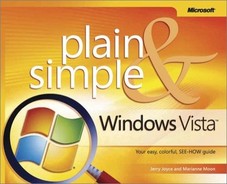In this section:
We all know that to work productively, with minimal stress and frustration, we must get organized! That’s where Windows Vista comes in. Windows Vista supplies the framework—a basic file structure of drives and some ready-made folders, which you can either use as is or create your own file- and folder-management system. You can organize the files within the folders—alphabetically or by size, type, date, and so on—and move, copy, and rename files or groups of files. If you want the people who share the computer with you to have access to certain files and folders, you can put those items in folders that are designed to be shared. You can change the appearance of the windows in which you view your documents and folders, and, depending on the information you need, you can view them in any of seven different views.
You can put the items you use every day on the computer’s Desktop, just as you do on a real desktop, and, to gain immediate access to a document you’re preparing, you can put a shortcut to it on the Desktop. You can take your files with you by copying them onto a removable memory device, and you can compress large files, either for storage or so that you can send them via e-mail. And you can use the handy toolbars to quickly and easily navigate your way through the information on your computer.
Although Windows Vista has seven view settings, there are actually just four major categories, one of which is a single category with four different sizes. The four major categories are Icons view, with the choice of four different sizes of icons; and List view; Details view; and Tiles view. Additionally, you can choose an icon size setting anywhere between the four standard size settings. You’ll probably want to experiment to see which view is best suited for your work and for the contents of your folders. For example, you might want to use Icons view in a folder that contains only a few files of different types, List view to see a vertical listing of files and folders, Details view when you’re looking for files that were created on a specific date, Tiles view when you’re managing pictures, and Extra Large Icons view when you’re reviewing the pictures. The seven views are described in detail on these two pages.
Icons view: The four icon sizes are Extra Large, Large, Medium, and Small. In most cases, it’s only the size of the icon—not its content—that changes in any of these four settings. However, in Small Icons view, you’ll see only the icons; in the other views, Windows Vista shows you a preview of the file—if it’s available—as part of the icon. Each icon size has its purpose. For example, the Extra Large Icons setting is the best way to view pictures in detail, and to get a good view of the contents of a folder and its subfolders. It is, however, an inefficient use of space to have a file represented only by an icon. On the other hand, the Small Icons setting lets you view a large number of files but provides little detail about pictures, file contents, or folder contents. The icons are arranged in horizontal rows, and, if there are too many files to be shown in the window at one time, you simply scroll vertically to see the remaining files.
List view: This view displays small icons representing files and folders in a vertical listing that can snake through multiple columns. The name of the folder or file is listed next to the icon. If there are too many files to be shown in the window, you scroll horizontally to see the additional columns and the remaining files.
Details view: This view displays small icons in a single-column list that shows the name of the file or folder and includes details such as size, type, and date. The details shown depend on the types of files in the folder, and you can customize the details that are shown. If you can’t see all the details, just scroll horizontally to see the additional details. If there are too many files to be shown in the window, you scroll vertically to see the remaining files.
Tiles view: This view displays medium-sized icons that include the name of the file or folder, the file type, and the file size. The tiles are arranged horizontally in as many columns as will fit within the window. If there are too many files to be shown in the window, you scroll vertically to see the remaining files.
After you’ve chosen the view you want, Windows Vista offers more options. In each view, you can arrange the way the files are sorted—for example, you can arrange the files in order by name, size, file type, or date. If you prefer, you can arrange the files in groups or include only items that fit specific parameters. You can also show different panes in the window—the Navigation pane to open other folders, the Details pane to show the metadata (such as title, tags, author, and size), and the Preview pane to show a preview, if available, of the selected item. These panes provide this information regardless of which view you’re using.




